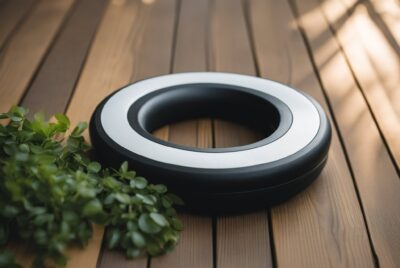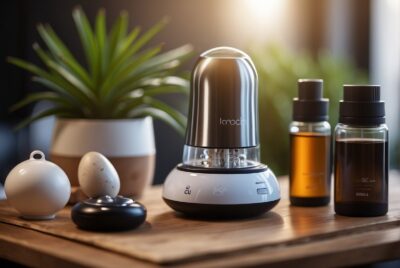Acupuncture Pen: The Modern Healing Tool
*We may earn a commission for purchases made using our links. Please see our disclosure to learn more.
Acupuncture Pen Benefits: Unlocking the Power of Portable Acupressure
I recently discovered the acupuncture pen, a modern adaptation of the ancient practice of acupuncture. Unlike traditional acupuncture which uses needles, this device is a needle-free alternative designed to provide similar therapeutic benefits. It’s tailored for those interested in acupuncture’s promise of pain relief and wellness but hesitant about the invasiveness of needles. The acupuncture pen operates on the principles of acupressure, targeting specific points on the body to stimulate energy flow, relieve stress, and alleviate pain.

While exploring the world of contemporary health gadgets, I found that the acupuncture pen is relatively simple to use, even for beginners. It’s a handheld device that emits an electrical impulse to stimulate acupoints along the body’s meridians. The science behind it borrows heavily from traditional acupuncture treatment, aiming to restore balance within the body by encouraging energy, or qi, to flow unhindered. Its portability and user-friendliness make it a versatile option for managing chronic aches or day-to-day stress.
My investigation into the acupuncture pen also revealed a variety of options on the market, some boasting advanced features like multiple intensity controls for personalized treatment. It’s intriguing to observe how traditional methods are blended with modern technology to create tools intended to enhance our health and wellbeing. As an advocate for complementary therapies, I evaluate these developments with a critical yet optimistic eye, recognizing their potential in the broader narrative of holistic health solutions.
Understanding Acupuncture Pens

In this section, I’ll explore the foundational concepts of acupuncture and acupressure, and elucidate the distinct attributes of traditional and laser acupuncture pens.
The Basics of Acupuncture and Acupressure
Acupuncture is a traditional Chinese medicine practice that involves inserting thin needles into the body’s specific acupuncture points. These points are believed to lie on meridians along which qi, or vital energy, flows. Acupressure, on the other hand, uses the same points but applies pressure instead of puncturing the skin.
The core idea behind both methods is to stimulate the body’s self-healing mechanism by promoting energy flow and balance. Here’s a quick comparison:
- Acupuncture:
- Tools: Thin needles.
- Technique: Insertion to varying depths at acupuncture points.
- Acupressure:
- Tools: Fingers, palms, elbows, or special devices.
- Technique: Application of pressure on acupuncture points.
Key Differences Between Traditional and Laser Acupuncture Pens
Traditional acupuncture relies on the manual insertion of needles, which requires precision and can only be performed by skilled practitioners. Laser acupuncture pens, a modern adaptation, use focused light, typically from a low-level laser, to stimulate acupuncture points without skin penetration.
- Traditional Acupuncture Pen:
- May require conductive gels.
- Provides direct physical stimulation of acupuncture points.
- Laser Acupuncture Pen:
- Often incorporates light or electrical impulses.
- Non-invasive and can sometimes be more easily self-administered.
In my experience, those interested in the convenience of self-treatment, especially those with a needle aversion, may prefer laser acupuncture pens. Although some assert that these devices can aid in the relief of pain or in facial firming, it’s essential to acknowledge that individual results can vary and should be regarded with a degree of caution. As always, it is advisable to consult a qualified healthcare professional before beginning any new treatment.
How Acupuncture Pens Work

Acupuncture pens utilize modern technology to emulate the effects of traditional acupuncture without the use of needles. Through electrical stimulation, they aim to stimulate the body’s meridians and encourage energy flow.
Mechanism of Action
I understand that acupuncture pens work by directing an electric pulse to various acupuncture or meridian points on the body. This is considered to help in balancing the flow of energy, or Qi, which is a fundamental concept in Traditional Chinese Medicine (TCM). By stimulating these points, the pens may offer relief from pain and other ailments.
Electrical Stimulation and Frequency
The electrical stimulation, integral to the efficacy of acupuncture pens, needs to be delivered at an appropriate frequency. I have learned that these devices often feature adjustable settings to control the intensity and frequency of the electric pulse. A conductive electrolyte gel is sometimes applied to the skin before using the acupuncture pen to enhance conductivity and ensure maximum effectiveness.
Understanding Meridian Points
My research indicates that the body’s meridian points act as pathways for energy flow. By applying the pen’s electrode tip to these specific points, it’s believed that the device can help restore balance within the body. Some acupuncture pens also come equipped with lasers to aid in identifying these points for precise application.
Benefits and Uses of Acupuncture Pens

In my exploration of acupuncture pens, I’ve identified several key benefits these innovative devices offer. They are particularly renowned for their convenience and non-invasive approach to pain management.
Pain Management and Relief
I’ve found acupuncture pens to be effective for various types of pain relief. They are often used to alleviate chronic pain conditions such as arthritis and sciatica. The electrical stimulation from these pens can target areas like the joints, neck, shoulders, and back, providing relief from joint pain, neck pain, shoulder pain, knee pain, and lower back pain. Acupuncture pens can also be quite beneficial for reducing headache frequency and intensity.
- Chronic Pain: Can help in managing symptoms of long-lasting conditions.
- Menstrual Cramps: Offers a drug-free alternative to ease the discomfort.
- Muscular Pain: Useful for both immediate relief and long-term management.
Promoting Blood Circulation and Relaxation
I’ve observed that acupuncture pens also promote increased blood circulation, which is a vital component of the body’s healing process. The improved circulation can lead to better overall relaxation and contribute to the reduction of stress and anxiety levels. This in turn can help with issues like fatigue and improve sleep quality.
- Blood Circulation: Enhances flow and promotes body’s natural healing response.
- Relaxation: Aids in mitigating mental stress and promotes a calm mental state.
- Sleep: By easing the body, may contribute to improved sleep patterns.
Other Therapeutic Applications
The potential therapeutic applications of acupuncture pens extend beyond pain and relaxation. They might play a role in supporting healthy weight loss by targeting specific acupuncture points that can help regulate appetite. Moreover, there are indications that the use of acupuncture pens could have a positive impact on immunity, as stress reduction is linked to the strengthening of the immune system.
- Mental Disorders: May alleviate symptoms associated with anxiety and stress.
- Healthy Weight Loss: Could assist in appetite control when combined with diet and exercise.
- Immunity: Lowering stress might indirectly contribute to improved immune function.
Practical Guidance on Using Acupuncture Pens

When considering the incorporation of acupuncture pens into your self-care regimen, it’s essential to carefully choose a suitable device, understand the safe practices for their use, and know how to maintain them. Let me guide you through these critical aspects.
Selecting the Right Acupuncture Pen
Selecting an acupuncture pen requires attention to features that enhance its effectiveness and safety. I look for FDA-approved pens that offer versatility in their use, with multiple attachments like dome-shaped extensions for broader areas or pinpoint tips for precise stimulation. Auto shut-off is another functional aspect that ensures the device won’t overwork, potentially extending the pen’s life.
- Features to consider:
- FDA approval for safety assurance
- Variety of attachments for different acupuncture points
- Auto shut-off feature for additional security
- Warranty to protect against defects
How to Safely Use an Acupuncture Pen
Safety and technique are paramount when I use an acupuncture pen. First and foremost, I ensure my skin is clean, and I apply conductive cream or gel to enhance the pen’s effectiveness. During use, I start with a lower intensity, increasing it gradually to a comfortable level. Caution is necessary to avoid overstimulation, particularly if dizziness or discomfort is experienced.
- Steps for Safe Usage:
- Clean the skin area where the pen will be applied.
- Apply conductive cream or gel to improve conductivity.
- Begin with low intensity, adjusting slowly.
- Do not apply excessive pressure or overstimulate.
Maintenance and Care
My acupuncture pen requires routine maintenance to ensure it remains safe to use and effective. After each use, I sterilize the tip with alcohol wipes to prevent any potential skin irritation or infection. I also make sure to check the device’s condition regularly, especially the battery compartment and attachments. To not void any warranty, I follow the manufacturer’s manual for specific maintenance guidelines.
- Maintenance Checklist:
- Sterilize the tip after each use with an alcohol wipe.
- Regularly inspect the battery and attachments.
- Consult the manual for manufacturer’s care instructions.
- Store in a dry, safe place to prevent damage.
Potential Side Effects and Considerations

In addressing acupuncture pen use, it’s essential for me to discuss not only the potential side effects but also the situations demanding caution. These devices, while beneficial for many, come with their own set of risks and considerations.
Understanding the Risks with an Acupuncture Pen
Acupuncture pens deliver electric pulses to acupoints, simulating the effects of traditional acupuncture needles. The side effects of using such a device typically align with those of traditional acupuncture. For instance:
- Common side effects: Minor bleeding, bruising at the point of application.
- Skin-related reactions: Rashes or infections if the device isn’t clean or misused.
- Sensory symptoms: Nausea, dizziness, or fainting might occur in some individuals.
- Pain: While the device is meant to alleviate pain, discomfort during use can happen.
- Other symptoms: Rare cases involve vomiting, tinnitus, or aggravation of mental disorders.
When to Exercise Caution
I advise certain groups to be particularly cautious when considering the use of an acupuncture pen:
- Mental Health Conditions: Those with PTSD, depression, or other mental disorders should consult with a healthcare professional, as electric pulses could impact their conditions.
- Chronic Illnesses: Patients with arthritis, paralysis, insomnia, or undergoing chemotherapy might experience different levels of efficacy or side effects.
- Pre-existing Conditions: It’s critical for individuals with a history of seizures or heart disorders to seek medical advice before use.
My insight into these considerations is intended to ensure safe and informed use of acupuncture pens.
Frequently Asked Questions
In this section, I provide answers to some of the most common questions about electric acupuncture pens.
1. What are the potential side effects of using an electric acupuncture pen?
While acupuncture pens are generally safe, potential side effects can include mild discomfort, redness, or swelling at the site of application. It’s essential to read the manual and understand how to use the device properly to minimize these risks.
2. How do I properly use an acupuncture pen on pressure points?
To use an acupuncture pen correctly, first identify the acupoint you wish to target. After applying any conductive gel if required, gently place the pen’s tip on the point and slowly adjust the intensity according to your comfort level. It’s important to refer to the user guide for detailed instructions.
3. Which acupuncture pen models are considered the best in the market?
Several models are highly regarded for their effectiveness and quality. Look for acupuncture pens with good customer reviews, adjustable intensity settings, and ergonomic designs. Some well-reviewed models include the HealthmateForever Handheld Electronic Pulse Massager and the iReliev TENS + EMS Therapeutic Wearable System.
4. Can you outline the benefits of using an acupuncture pen?
Using an acupuncture pen may provide pain relief, reduce muscle tension, and promote relaxation. It offers a portable and convenient alternative to traditional acupuncture treatments and can be used for self-care at home.
5. What should I look for in acupuncture pen reviews?
When reading acupuncture pen reviews, examine the feedback on the device’s ease of use, effectiveness, build quality, and battery life. Reviews can also inform you about customer service experiences and device longevity.




